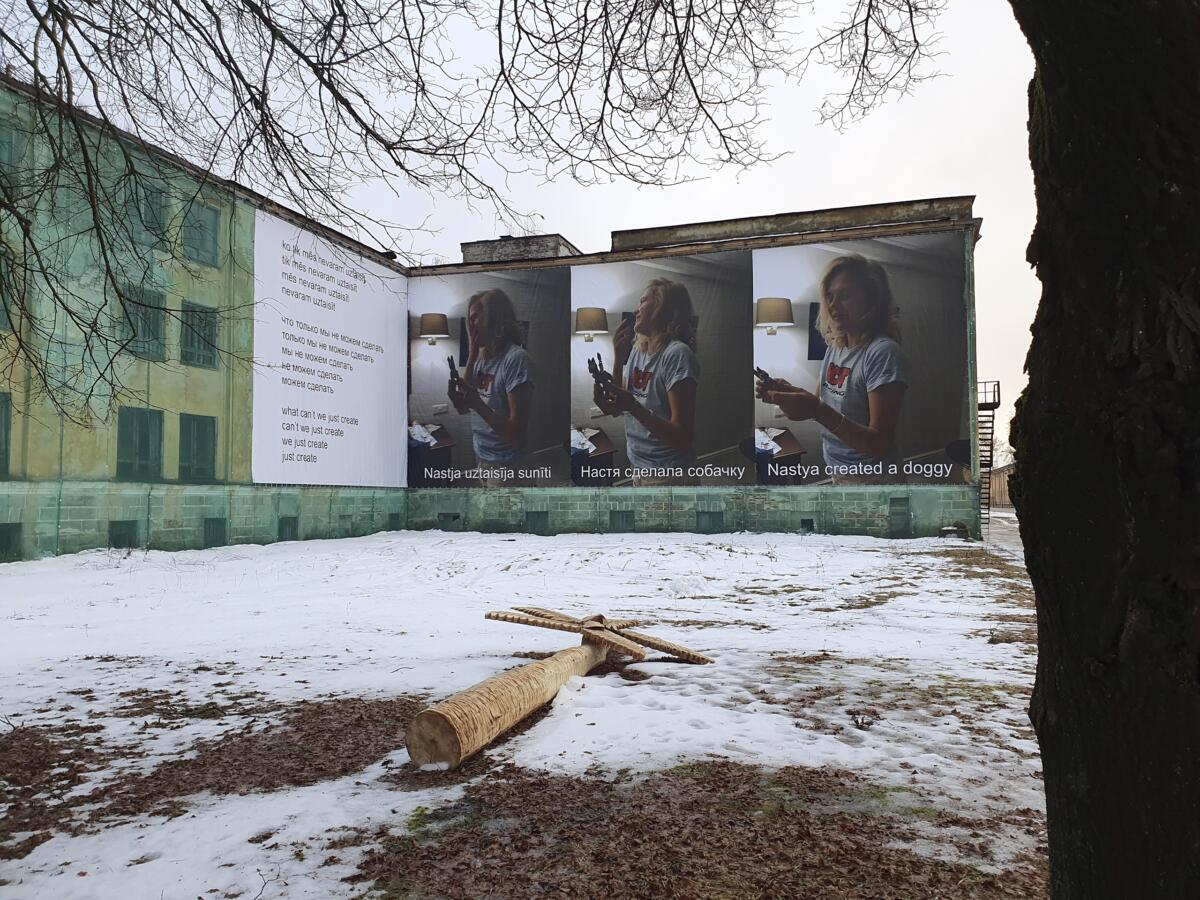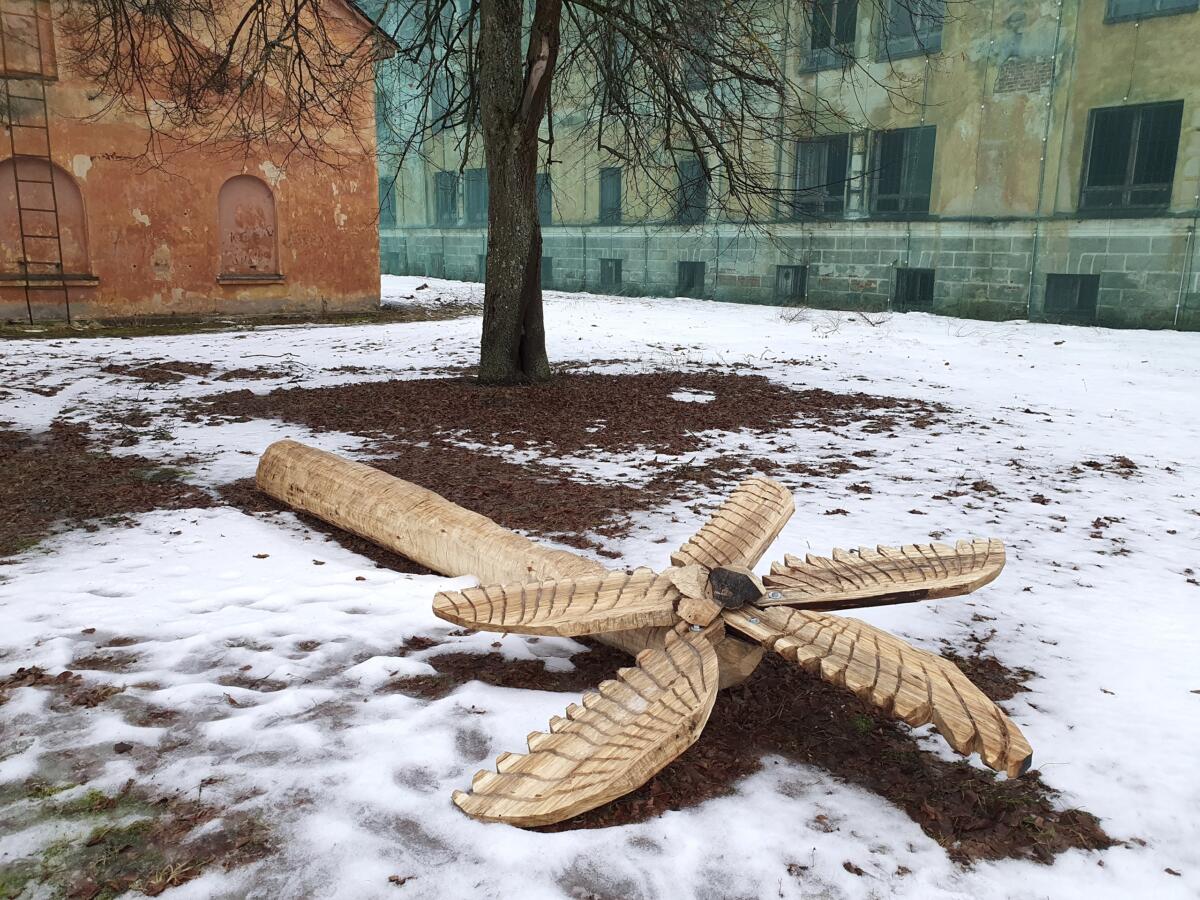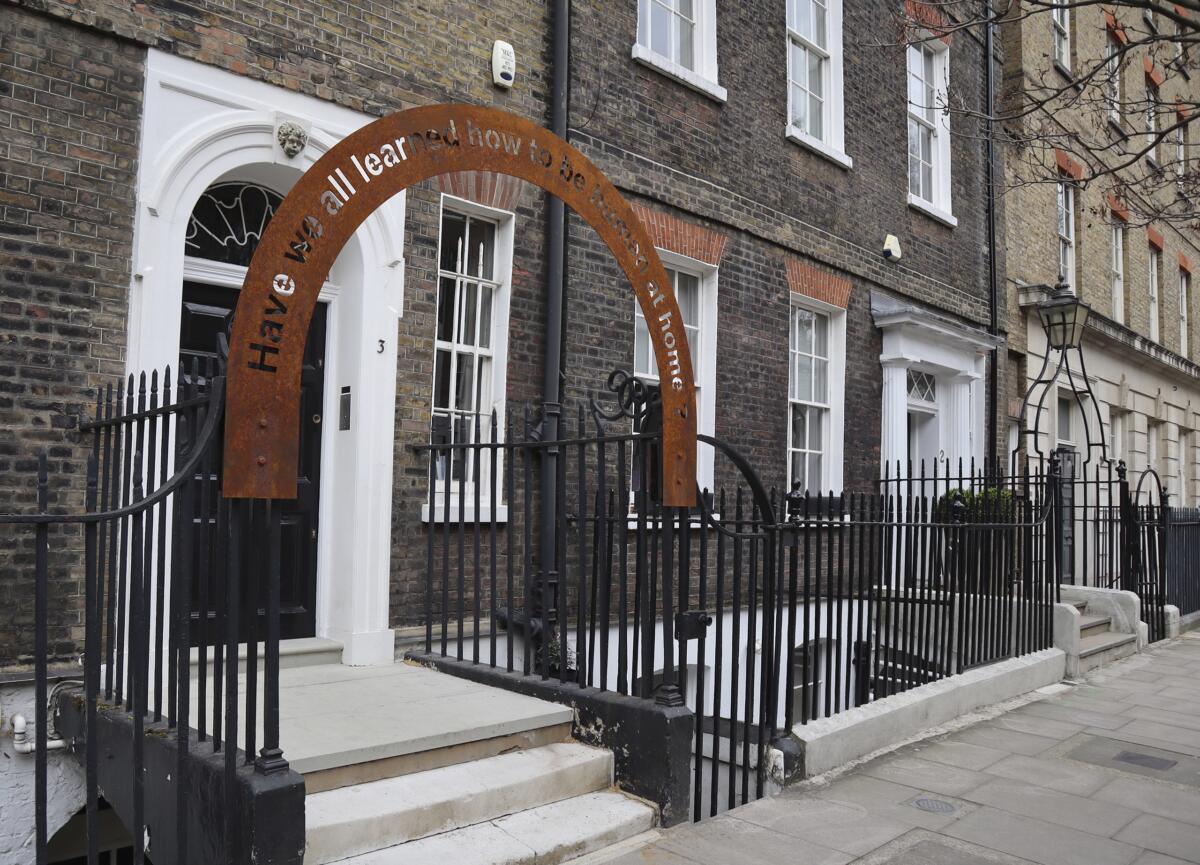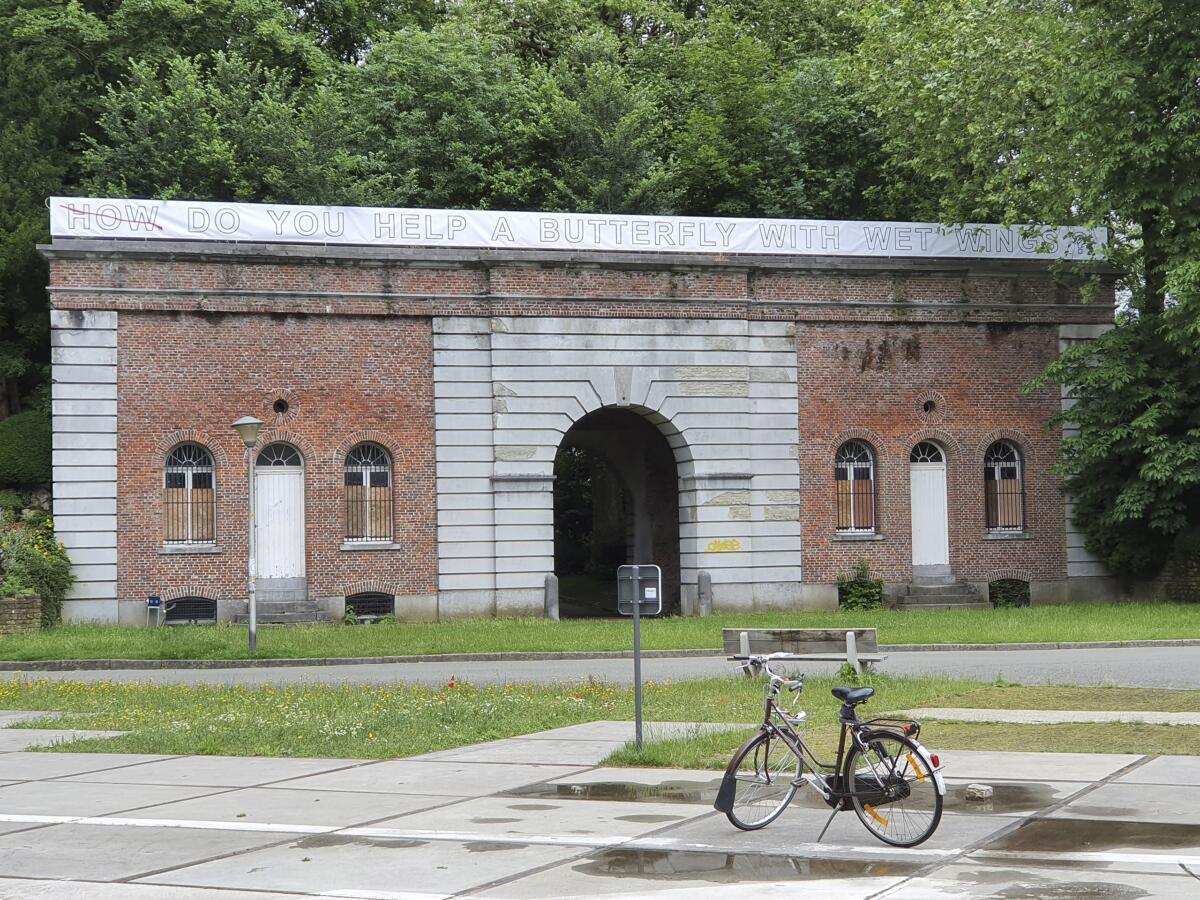
Before anything, the Latvian-British artist Kristaps Ancāns considers himself an explorer. Fuelled by the necessity to visualise and communicate as directly as possible, he plays with the hidden mechanisms behind the linguistic, cultural and contextual systems that define us. Through metaphorical and philosophical questions, quizzical puns and statements, Ancāns has developed a practice in site-specific installations, employing large-scale banners that immediately engage with the public. Based on topical issues culled from media and literature, and stories from his own cultural heritage and identity, the artist charts dynamic and unexpected relationships between language, context and image.
Indeed, language is a primary form of communication, expression, and even protest, and with his recent works, Ancāns explores how ambiguity and humour allow for multiple interpretations, stimulating questions (as well as emotions) without giving definitive answers. From the 1960s, artists have used language and text as the basis for their works, including the “concrete poets” who challenged traditional experiences of reading to capture the viewer’s imagination. Ancāns’s recent textual works, in various contexts of Eastern and Western Europe, build on this tradition, which have had an indelible and international impact during the social-political instability that has ensued after the pandemic crisis. The evolution of his practice attests to the inability to categorise his work by geography alone, approaching the making of public art from a social perspective. For the viewer, these projects emphasize a heightened awareness and a direct experience of the seemingly quotidian buildings and sites in shared public spaces.
It is this fresh approach and relevance to international dialogue that particularly piqued my interest in Ancāns’s work, prompting me to find out more about the integration of architecture in his practice along with an embrace of non-traditional installation materials. The precision and conceptual clarity of his projects facilitate a free-spirited lack of preciousness coupled with a keen awareness of the details of each piece and the specificity of each context of where the sites sit.
Have we all learned how to be human at home? (2021), a sculptural installation presented in London (where the artist also lives), was installed over the threshold of domobaal gallery. The installation consisted of a laser-cut steel arch with the aforementioned question cut out from rusted metal. According to the artist, the shape itself is in dialogue with other arches in the city, such as the famous black double arches of 10 Downing Street, the imposing archway over a football stadium turned into a makeshift coronavirus testing site, or the arch of a community garden that became a reliable food system during major disruptions in the supply of nourishment.
The installation facing passers-by on John Street in Central London was installed when pandemic lockdown restrictions were beginning to be relaxed across the UK in March of 2021. With a touch of dark humour, this seemingly innocent question almost functioned as a warning—that an already-critical situation was about to get worse. Inspired by the quotidian yet visually engaging form visible across the British capital, Ancāns gives special meaning and distinctive value to the arch, creating a new and personal approach. Conceptually, the work became an unstable sculpture, interpreted or watched from a mixture of subjective experiences, eliciting a flux of responses both online and off. Positioning the viewer as an interlocutor, the artist tempers a sense of unease toward contemplation, invoking a sense of play into the underlying menace of the real.
One of his most recent textual works, How do you help a butterfly with wet wings? (2021), was a site-specific installation at Citadelpark in Ghent, Belgium. Within the framework of an exhibition titled, “Publiek Park,” the work consisted of an opaque banner draped above the gatehouse, its aforementioned words in huge capital letters. Ancāns subverts the familiar appearance of the black text against a white background, enlarging it to the size of a long billboard. “How” is crossed out with a line of graffiti, which allows for a double reading: “How do you help a butterfly with wet wings?” / “Do you help a butterfly with wet wings?” Presented together with a science magazine entry on the development of butterfly wings, the instincts of insects and animals—when used as metaphors—provide brilliant insights into human behaviours and relationships.
For the artist, the question(s) irreverently summon the park’s culture as a gay cruising area while commenting on the fragility and resilience of LGBTQIA culture. Sitting across the historic inscriptions “L’Union Fair la Force” (in French: “Strength in unity”) and “Nemo me impune lacessit” (in Latin: “No one attacks me with impunity”) on the former citadel gate of Ghent, they create a carefully staged tension. Shared among the three languages, their contexts and meanings are laced with awareness and wit, set to the sounds of birds, insects and plants in the park. The artist’s deliberate use of double meanings in his cheeky question(s) also borrows from the world of advertising and signage, implying the malleable meaning of language and its dependence on a given context. This interplay between art and life, and language’s influence on perceived realities are at the crux of Ancāns’s work.
In What can’t we just create (2021–2022)—the artist’s first large-scale project for the Rothko Centre which I curated—Ancāns’s practice has grown both formally and conceptually. The project combines monumental banners with a site-specific sculpture: texts in black font on a white background (written in Latvian, Russian, and English), colour photography and a lone palm tree. Located on and around a disused building that once housed former air pilots and war machinery, the piece addresses the city and population of Daugavpils directly—its histories of perpetual war-readiness and traumas from national self-determination, including those who still live among the vestiges of the past, in an area that’s developing quickly. Ancāns’s project, located within the former military fortress, refers to constructions and confluences of language and context mechanisms inherited by and inherent of the site that’s actively transforming into a vibrant cultural hub and administrative centre for the region.
The artist’s approach for this new commission reflects the spirit of conceptual and critical practices of other previous projects, which also refer to urban life, popular culture and current political issues that cannot be readily pinned down as either “regional” or “national.” This project, instead, brings together elements of text and large-scale photography with sculpture and site-specific architecture to explore issues of national and cultural hybridity, as well as borders and identity. In this text, I look at the project through an art/historical lens, seeing how it converses with the past while still remaining forward-thinking today.
The wordplay in the aforementioned languages (“what can’t we just create / can’t we just create / we just create / just create”)—which ends on the negative form in Latvian (“nevaram uztaisīt”), and on the positive in Russian and English (“можем сделать” / “just create”)—functions as a “thinking image,” summoning concepts of otherness and of exhaustion towards their uncharted potentialities. On the banner, they are linked in a suggested yet unresolved symmetry. Who are the insiders? And who are those doomed to the periphery, somewhere other than the centre? The wordplay leaves us in a knotty paradox. As viewers, we are caught in the conundrum of remaining as outsiders, though equally joining the centre, as a consequence of being ex-Eastern Europeans in a former communist country (even though Latvia joined the EU in 2004). And for the Russian-speaking population of the country, the otherness of living in a double periphery of the EU is even more acutely complex.
Adjacent to the banner with text, the viewer encounters another tripartite: a brightly lit portrait of a young woman, who’s smiling while holding a miniature toy dog, captioned with “Nastya created a doggy” (short for “Anastasiya” in Russian) also translated in the other languages. Countering the artist’s penchant for the quick transmission of ideas through language, these banners temper direct communication with figurative, photographic experimentation. Ancāns employs spontaneity, chance and the unexpected in these unstaged personal photographs, which are as much about the documentation of a moment of joy as they are a metaphor for larger cultural and social circumstances. Nastya’s shifting portraits, seemingly fun and innocuous, are much more symbolic within the environment of a former military establishment. And through a gesture of playfulness, their inclusion stirs them to consider how a sense of otherness and sensations of fatigue, evoked by each corresponding banner, can be paradoxically flipped on its head. The portraits bring a carefully staged levity and spontaneity to the building’s austere façade—its exterior engulfed in green mesh, melded with the rich emerald setting and deep red on Nastya’s t-shirt, which provocatively reads “Hot Racing.”
Together, these banners visualise different aspects of the identity/language/geography nexus, from integration to otherness, verbal to nonverbal, corporeal to immaterial, tone to shade; they offer a glimpse of the shape, complexity and “colour” of the context/affect that they surround in this location, at this time in history. Given the ongoing social challenges that accompany efforts to solve social conflicts, especially in urban environments, Ancāns proposes that a completely new and surprising visual-textual regime can result in new understandings and solutions. Such witty ambiguities, reflecting the ethos and particularities of cities in which they are presented, have become a key part of the artist’s repertoire. They transform the site into a ludic realm of self-conscious laughter, for viewers can’t help but reflect on the realities that are portrayed, which contribute to their own sense of questioning, discomfort and awe.
Thinking about the project, the artist remarked: “In a world where many tongues are spoken—to understand or not to understand is mostly a choice. Would speaking in the same tongue bring us to a common language, as we even other family members, friends, colleagues and neighbours?” These observations and questioning bring more dimension to the notion of “othering”—applied not only to those of a different heritage or background but also to those who do not fall under the heteronormative societal values—expanding the connotations of the original reference to a specific context.
The textual patterns that reveal the conundrums of context and identity construction suggest connections between the artist’s work and “Concrete Poetry,” which emphasises visual and auditory content, and the form of language. Taken together, aspects of the otherwise-straightforward banners underscore the specific, namely each viewer’s particular relation to the exotic, or otherness, linking its specificity with the more common ideas of creating and coexisting. Ancāns uses humour to level emergent circumstances of conflict and alienation, undermining difference (exoticism) and foregrounding commonality (creation), instead.
In direct dialogue with the visual onslaught of the conditions of identity and sources of knowledge that entangle (inter)national narratives through language, the artist also created a sculpture of a resting palm tree (made of aspen wood) nestled between two linden trees that stand on-site. Ancāns’s sculpture is a fresh take on the appropriation and recycling of images, using local materials. It sets the stage for the installation in its entirety—the wavy trunk of the palm climbing upward, pointing toward the walls where the banners hang. Open to the public during the darkest and coldest time of the year in Latvia, the sculpture playfully contrasts with the bare trees, the dead foliage and the scattered snow all littered on-site. It creates a fantastic and almost-unreal experience of poetic wonder set across the backdrop of Soviet apartment blocks and a recently-renovated police building. In this expanse, the artist knows to fill and balance aesthetic information; to play with different scales, visual references and languages, translating the complexities of social behaviour into art.


While linden and aspen trees are native to the region (which may evoke a common sensation of familiarity), the palm’s sculptural form signifies exoticism, invoking individualistic notions of how another person might be considered “different.” At the University of Latvia’s Botanical Garden, palm trees are indeed a prized possession; as one of its main attractions, the Palm House, conjures the warmth of the tropics in the depths of harsh Baltic winters. The sculpture further pushes the viewer to meditate the often dark nature of humans and the world we have created. In this context, the palm is a signifier of human inconsistency, of anomaly and desire, and of loneliness in a foreign land. Its marked artificiality—rooted in local material, nonetheless—speaks to the incongruity of national/regional ideologies, the absurdity of strangeness and the difficulty of coming to terms with the Other.
What can’t we just create (2021-2022) is a daring proposition to the adversity of historical circumstances and conflicts. The work unifies disparate ideas and concepts to raise questions of the inelegant and alienated manners of relating to other human beings supplementary to ourselves, combining words and images, plays on language, ambiguity and displacement. Ancāns juxtaposes seemingly dissimilar elements that both surprise and humour our expectations and beliefs in identities and heritage; through language, it extends the capacity to invent, exist and enjoy oneself in spite of perceived limitations and adversities. And we laugh nervously, recognising that we—collectively—face these difficult and complicated questions together.
Edited by Katie Zazenski
Imprint
| Artist | Kristaps Ancāns |
| Exhibition | What can’t we just create |
| Place / venue | Daugavpils Mark Rothko Art Centre |
| Dates | 21.12.2021 until 30.06.2022 |
| Curated by | Corina L. Apostol |
| Website | www.rothkocenter.com/en/ |
| Index | Corina Apostol Daugavpils Mark Rothko Art Center Kristaps Ancāns |



